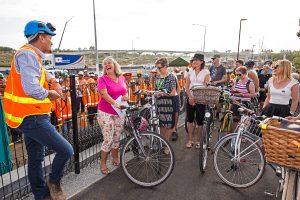This report provides highlights from my Waitematā Local Board activities during October 2015. It is included on the agenda of the Board’s November business meeting.

Highlights
Public Forum
Public forum at the Board’s October business meeting was one of our most interesting and thought-provoking with seven presentations covering a range of projects and issues. We are really fortunate that people in the Waitematā Local Board area are willing to take the time to engage with local government through our public forums.

Friends of St Davids, Grey Lynn Surrey Crescent shopsworking group, Hauora Gardens at Studio One, Brian McClure a local business landlord and the Grey Lynn pump track society also presented at the public forum.
Presentations that were tabled are available on the Council website.
Berm planting
Auckland Transport has done a great job sparking interest in berm planting! Local Board feedback on Auckland Transport’s draft berm planting guidelines was made available in October (our feedback was attached to the October agenda) leading to media coverage extending all the way to the BBC and a NZ gardener petition.
Disappointingly Auckland Transport incorrectly claimed in the media that the draft had been provided to local boards in confidence. Throughout the development of the draft guidelines AT has shown a lack of understanding of Local Board’s placemaking role and processes.


Ponsonby Road safety improvements
A new feeder lane and advance stop boxes (“fresh Kermit) have been installed on Ponsonby Road as part of Auckland Transport’s resurfacing project.
Report back: Future of Cycling symposium: Challenges and Possibilities
I attended the Future of Cycling symposium hosted by the University of Waikato and Cycling New Zealand at the Avantidrome in Cambridge on 2 October 2015.
The symposium was a first for bringing together academics, sports administrators, cycle advocates and representatives from transport agencies to discuss a range of cycling related issues and opportunities.
The symposium was opened by Andrew Matheson, CEO of Cycling NZ. He shared some interested statistics from research Cycling NZ has carried out:
– 23% of adults get on a bike at least once a year
– Half have high engagement with cycling
– High engagement riders are estimated to save our health economy $1 billion per year
I was particularly interested in presentations about safety and making cycling an everyday transport option. For example from a report back from the Cycle Safety conference in Germany we heard about new bike technology to make cycling safer for older people (in Holland cycling injuries and fatalities are very low by international standards but older people make up the largest and growing group of victims). It was recommended that rather than follow the lead of Europe we need to find our own safety solutions to meet them in the future.
Gerry Dance from NZTA reported that we are now “riding with a political tailwind” due to the increase in cycling investment from the government.
I attended the symposium with members Christopher Dempsey and Rob Thomas. Registration of $80 was paid from the Board’s professional development budget.
October events and functions
In addition to Local Board workshops and meetings I attended:
- Cycling symposium in Cambridge on 2 October
- Pecha Kucha Maritime edition at the Voyager Museum 8 October
- Art Week opening at Silo 6 on 9 October
- Auckland Refugees Council AGM on 10 October at the Grey Lynn Community Centre
- Kelmarna Spring Festival on 11 October
- Ponsonby Business Association Board meeting on 14 October
- Introduction to Local Board members by the new Panuku Development Agency
- At the Beach NZ Fashion Museum launch at Voyager Museum on 15 October
- Spring Fling in the Myers Park underpass on 16 October
- Diwali Festival opening ceremony in Aotea Square on 17 October
- Grey Lynn Farmers Market AGM on 18 October (I have now resigned from the Grey Lynn Farmers Market management committee after 5 years as Chair )
- Bikes vs Cars documentary screening on 18 October
- Ports of Auckland community reference group meeting
- Presentation by the world homeless expert Dr Sam Tsemberis, Pathways to Housing, NYC at Merge Café hosted by Lifewise on 20 October
- Opening of the Screenies International children’s film festival at TAPAC on 22 October
- Inner city network meeting to discuss neighbours day 2016 preparations
- Ponsonby Business Association AGM on 27 October
- The Lesson opening night at Basement Theatre on 27 October
- Franklin Road community liaison group meeting on 28 October (to discuss the latest options for the upgrade of Franklin Road)

















